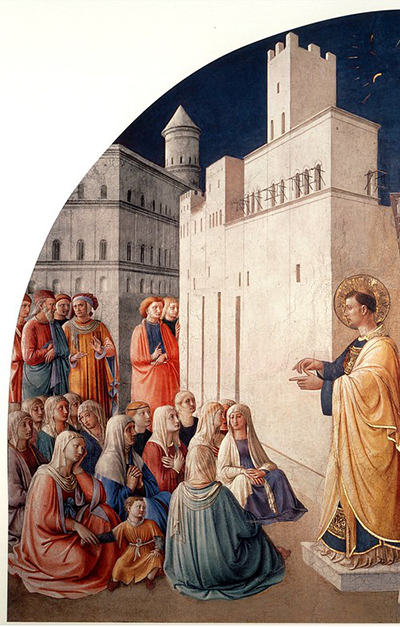Fra Angelico produced a series of frescoes to adorn the Chapel of Nicholas V in the Apostolic Palace of Vatican City. Between the years of 1445 to 1449 the artist would work particularly intensely within Rome, and Saint Stephen Preaching would have been started in around 1448.
The artist's work for the Cappella Niccolina would focus on the lives of Saint Stephen and Saint Lawrence, producing a number of different scenes from their respective lives. Each one featured a charming mixture of architecture, landscape and figurative art and by this point of his career, Fra Angelico had absolutely reached the summit of his talents. As with many of his other projects in later life, the artist was tasked with adapting his work to fit the intricate layout of these historical buildings, though in some cases he simply needed to curve out sides of each fresco. Many of the frescoes that he produced within the palace are instantly recognisable as Fra Angelico's, with his signature style fully developed by this stage of his career. Even when placed against some of the other notable art displayed in Vatican City, this series of frescoes still receives considerable interest from visitors and art historians.
Saint Stephen was the first Christian martyr and the important details of his life are touched on within this painting. He speaks directly to his congregation with passion and vigour, as they listen intently to his every word. Sadly, his persistency would lead to his demise, after he was removed from the city walls before then being stoned to death. Fra Angelico within this fresco is dressed in a yellow robe, with touches of blue underneath. His halo denotes his saint-status and is delivered with gold paint and the artist would normally do with others. Whilst many figures are closely placed together, suggesting his popularity and demand for his ideas, the artist also captures the city itself with walls of architecture decorating this delightful scene. Most sit in the foreground, though several other figures in the background are stood, with the two groups separated by gender.
The overall measurement for the two Saint Stephen frescoes is 6.6 metres in width and 4 metres in height, with the two items being roughly the same size as each other. Both are curved around the top in order to match the design of the chapel wall. One of the purposes of the artist's work within the chapel was to draw closely together the Church of Jerusalem and the Church of Rome, by providing a cross over in content and a similarity in some aspects of their history. Most religious art would have a purpose behind it rather than merely to provide aesthetic interest, and its role could vary from strengthening the commitment of the congregation to further installing particular values from Christian scripture.




